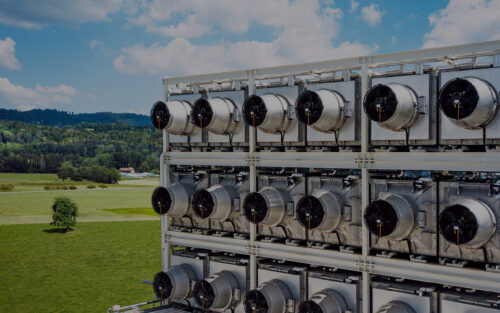Charting a Course: Strategic Planning for Marine CDR MRV
A tool to facilitate the planning and communication of monitoring, reporting, and verification (MRV) for marine CDR.

How RMI Is Supporting an Essential New Field
Efforts to reduce emissions — by shifting to clean energy and industries — remain RMI’s top priority to avoid the worst consequences of climate change. Yet, based on the best available science, emission reductions alone likely won’t be enough to guarantee a secure planet for future generations.
To avoid catastrophic climate change, the UN Intergovernmental Panel on Climate Change (IPCC) has concluded that, in addition to slashing emissions, we must remove up to 13 gigatons of carbon dioxide from our atmosphere annually by 2050.
A recent IPCC report makes the need for carbon dioxide removal (CDR) even more explicit: “The deployment of CDR to counterbalance hard-to-abate residual emissions is unavoidable if net zero carbon dioxide or greenhouse gas emissions are to be achieved”.
Carbon dioxide removal (CDR) is likely to be needed to fulfill three roles that cannot be accomplished by emissions reductions alone:
RMI’s approach to scaling CDR to meet this vital need is to catalyze open science, rapid innovation, new markets, and well-considered national- and state-level policies that address the concerns of the scientific community and the communities who have a stake in how CDR is deployed.
On the supply side, RMI supports work that helps implement scientific innovation, helps startup and early-stage ventures succeed, enriches community engagement, and advances commercial-scale demonstration projects.
On the demand side, RMI works to advance rigorous assessment frameworks, standards, and policy for the emerging CDR marketplace. We also work to identify best-fit solutions for specific geographies and industries.
The foundational pieces below lay out RMI’s approach to ensuring CDR’s responsible development.
Scroll further to see additional research, insights, and articles, and to meet our expert team.

RMI’s Applied Innovation Roadmap for Carbon Dioxide Removal (AIR) delivers a comprehensive, objective, and action-oriented perspective on what is needed to achieve technical readiness at scale of 32 carbon dioxide removal (CDR) approaches. The roadmap is designed with a wide range of readers in mind, including policymakers, public and private sector funders, technology developers, and research organizations. It includes in-depth assessments of opportunities for innovation, barriers to implementation, and pathways for integrating CDR into a low-carbon future.

RMI’s State CDR Atlas offers state policymakers tailored insights to support the adoption of Carbon Dioxide Removal (CDR) solutions. This interactive atlas analyzes each U.S. state's unique characteristics, highlighting opportunities for CDR approaches that align with resources, infrastructure, workforce, and more. Our analysis on enabling state-level CDR policies highlights gaps in existing policy landscapes and provides strategies for driving impactful CDR initiatives, helping stakeholders create a regulatory environment that enables new projects and addresses policy gaps.

RMI is collaborating with Carbon Gap, Europe’s leading carbon dioxide removal (CDR) advocacy and research NGO, to produce national Carbon Removal Readiness Assessments. These reports assess the real-word potential to deploy CDR through a bottom-up approach, taking into account technical limitations based on the availability of the resources needed to carry out carbon removal activities, and local limitations associated with the social and regulatory context of the country. The first report highlights opportunities for France.

Scaling Technological Greenhouse Gas Removal: A Global Roadmap to 2050, developed by RMI in collaboration with the Bezos Earth Fund, charts a course to rapidly scale technological greenhouse gas removal (GHGR) over the next several decades. Our analysis of the massive scale required for CDR in climate goals highlights the complexity of this challenge. However, this roadmap aligns actions and investments across sectors and stakeholders, including government actors at all levels, funders, GHGR communities, industry, researchers, journalists and media, and nonprofits and civil society organizations.
A tool to facilitate the planning and communication of monitoring, reporting, and verification (MRV) for marine CDR.
SBTi is considering how to further integrate a science-based approach to carbon dioxide removal into the v2 Corporate Net-Zero Standard. To inform this work, a group of experts has developed the following design recommendations that SBTi can adopt to create a science-based framework.
Carbon dioxide removal taxonomies abound, but by mapping the journey of a carbon atom we can find hidden links and opportunities.
The scale, challenges, and what is needed to advance carbon removal and storage in bio-based building materials.
To reach net zero, and go beyond, heavy industries need to adopt carbon removal practices
How much CO2 we’ll need to remove from the atmosphere — in addition to direct decarbonization goals — in five charts.
Four carbon dioxide removal company CEOs weigh in on challenges, innovations, and the path to scale the industry.
CDR approaches are more diverse than many realize. To achieve the scale of carbon removal the world will need, it’s essential to explore many options in many places.
RMI’s approach to classifying 32 unique carbon dioxide removal approaches by key resource inputs, to advance a collectively diversified and scalable portfolio.
Excess reliance on CDR could slow or increase the cost of reaching our climate goals, so reduction should be prioritized wherever possible. However, the science is clear: CDR will be needed to reach those goals.
This technology could be a significant piece of the carbon removal puzzle, but we need to act now for it to make a meaningful impact.
some degree of nature-based or engineered carbon dioxide removal (CDR) solutions are now widely seen as necessary for removing residual emissions.
According to the latest science, the risk of catastrophic climate change grows significantly if the world warms by more than 1.5°C against its long-term average.
RMI has experts with perspectives across CDR solutions, including direct air carbon capture and storage (DACCS), geochemical CDR, and biomass, in addition to the larger CDR ecosystem. For media and speaking opportunities, please contact media@rmi.org.